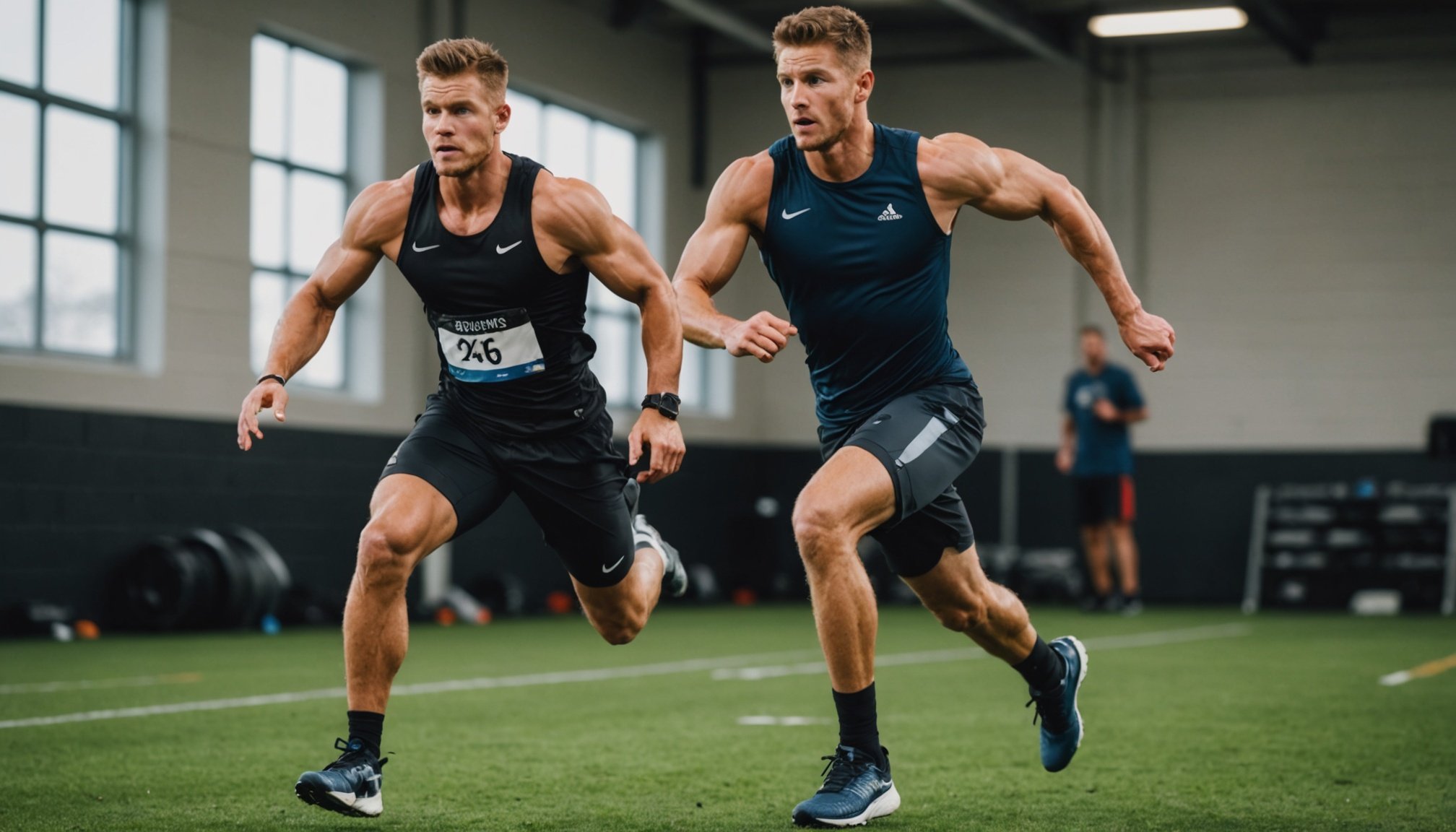Overview of Wearable Technology in Sports
Wearable technology has become a game-changer in the sports industry, offering athletes and coaches valuable insights into training and performance. But what exactly is wearable technology? Generally, these are devices that can be worn on the body to monitor various physical metrics. Examples include fitness trackers, smartwatches, heart rate monitors, and even smart clothing.
One primary role of wearable technology is to enhance athletic performance. By providing real-time data on metrics such as heart rate, speed, and distance, athletes can adjust their training regimes for optimum results. This technology allows for tailored training programs that focus on specific areas such as endurance or agility.
Also to see : Empower your dance: the ultimate safe and effective strength training guide for dancers
The evolution of wearable technology has seen significant advancements. Initially focused on basic tracking, modern devices now integrate complex algorithms and machine learning to deliver deeper insights. This advancement has spurred sports innovation, allowing for precision in performance analysis and injury prevention.
Thus, wearable technology is not merely a trend but a crucial element in modern sports. It pushes the boundaries of athletic performance and introduces new ways for sports professionals to compete at their best.
Also read : Maximizing gymnastics potential: how proprioceptive training enhances athletic excellence
Benefits of Wearable Tech for Athletes
Wearable technology offers significant benefits to athletes, particularly by enhancing athlete performance through real-time data collection. Devices such as fitness trackers and smartwatches continuously monitor physical activities, providing immediate feedback. This allows for tailored adjustments to training programs, promoting more effective workouts. Real-time analytics enable trainers and athletes to make informed decisions regarding training intensity and duration.
Another crucial advantage of wearable tech is its role in enhanced recovery. By monitoring physiological metrics like heart rate variability and sleep patterns, athletes can optimise their recovery protocols. Understanding these metrics helps in preventing overtraining, reducing injury risk and ultimately improving long-term performance.
Additionally, data analytics derived from wearable technology profoundly influence performance outcomes. By analysing patterns and trends within the collected data, coaches and athletes can identify strengths and weaknesses, allowing for targeted interventions. This data-driven approach ensures training regimens are as efficient and effective as possible.
Overall, the benefits of wearable technology extend beyond simple fitness tracking to provide deep insights into athletic performance. These insights facilitate strategic training decisions and promote holistic athlete development. Wearable tech transforms raw data into actionable strategies, enhancing overall athletic performance.
Popular Wearable Tech Products for Athletes
Innovative wearable tech products have become essential for athletes aiming to optimize their performance. These devices enhance training and provide actionable insights into one’s health. From fitness trackers to smart sports gear, there’s a wide range of options available.
Smartwatches and Fitness Trackers
Smartwatches and fitness trackers are highly popular due to their ability to monitor physical activity and analyse health metrics. They track steps, calories, and sleep, providing comprehensive data for personal and professional use. With features like heart rate monitoring and GPS tracking, these gadgets are indispensable for athletes wanting to track their progress.
Heart Rate Monitors
Heart rate monitors are vital for athletes focused on endurance and cardiovascular health. These monitors provide real-time insights into heart rate patterns, enabling users to maintain optimal exertion levels during workouts. Popular brands offer various models tailored to different training intensities, making them suitable for both amateurs and professionals.
GPS Trackers
GPS trackers offer a unique advantage by providing precise location data, perfect for runners and cyclists. They help athletes map routes, calculate distance, and evaluate speed. With their ability to sync with other smart gear, they provide a comprehensive overview of your training regime. These trackers are perfect for athletes looking to enhance outdoor activities and analyze geographic performance patterns.
Case Studies and Success Stories
Wearable technology has revolutionised training methods, particularly in sports. Numerous athletes have harnessed this innovation to optimise their performance through real-time data insights. Notably, professional swimmer Katie Ledecky uses smart goggles to monitor her speed and stroke efficiency, translating data into improvements. Similarly, Tom Brady, a legendary NFL quarterback, benefits from smart health bands tracking his health metrics, allowing precision adjustments in his training routine.
Leveraging wearables, sports professionals can see substantial performance improvements. For instance, marathon runners using heart rate monitors have enhanced their pace, as evidenced by consistently faster times. The integration of wearables acts as an underlining system that augments athletes’ capabilities.
A comparative analysis highlights the dramatic results achieved before and after incorporating wearables into training regimes. Prior to adoption, data was often anecdotal or reliant on coaches’ insights. Post-adoption, wearables deliver accurate, data-driven feedback, enabling athletes to make informed adjustments swiftly. This results in minimised injury risk and maximised performance gains.
These wearable technology success stories illustrate how devices empower athletes. By understanding how to utilise such data, athletes can maintain an edge over competitors, proving transformative in the sport’s landscape.
Data Tracking and Analysis in Training
Accurate data analysis plays a crucial role in modern training regimens, enabling athletes to optimise their performance. Advanced tools and software provide valuable insights by tracking various athlete metrics, from speed and heart rate to recovery times. Precision in data capture ensures that the information used for analysis truly reflects the athlete’s condition, making the insights gained far more reliable.
When tackling performance tracking, employing the right tools can be a game-changer. Software that integrates with wearable technology allows for real-time monitoring, offering a comprehensive view of an athlete’s efforts. This holistic perspective empowers coaches and athletes to make informed decisions regarding adjustments to training schedules or intensities.
Interpreting data effectively is essential for turning numbers into knowledge. By analysing metrics, such as athlete metrics and performance indicators, actionable insights can emerge, highlighting areas for improvement or emphasizing strengths. This analysis is key in crafting personalized training plans that cater to the unique needs of each athlete.
In summary, the balance between data accuracy and insightful analysis can significantly enhance training outcomes, providing clarity and direction in the pursuit of athletic excellence.
Integrating Wearable Tech into Training Programs
Incorporating wearable tech into training programs can enhance performance by providing real-time data and insights. One of the best practices is to start with a clear understanding of your training goals and choose technology that aligns with these objectives. This ensures that the technology serves its purpose in effectively adapting to sports training methodologies.
Overcoming challenges in technology adoption often involves addressing user adaptability and ensuring the training integration process is seamless. Athletes and trainers can be resistant to new technologies due to unfamiliarity. Providing proper education and training on using the devices helps ease this transition. Furthermore, choosing wearable tech that is user-friendly and compatible with existing training systems is crucial.
Crafting personalized training plans using data from these devices allows for targeted improvements. Analyzing metrics such as heart rate, movement patterns, and caloric expenditure helps devise programs that cater to individual needs. Tailoring workouts based on this information maximizes efficiency and reduces the risk of overtraining or injury.
By integrating wearable tech into training, one can ensure that training is not only personalized but also technologically advanced, ultimately leading to better outcomes and optimization of performance.
Limitations and Considerations of Wearable Technology
As wearable technology becomes increasingly popular in sports, it’s crucial to understand its limitations and challenges. One significant concern is the potential inaccuracies in data collection. Users often rely on these devices for precise information, yet factors such as electronic interference or physical obstructions can compromise data reliability.
A critical challenge arises with the use of this technology in sports: managing data security and athlete privacy. Wearable devices collect vast amounts of personal and biometric information, presenting risks if this data is not securely handled. Ensuring robust security measures and clear data usage policies is essential to protecting individuals using these devices.
Balancing the use of these technologies with traditional training methods poses another consideration. The effectiveness of wearable tech in enhancing performance should not overshadow the importance of age-old training techniques. Traditions in coaching and hands-on practices still hold immense value and can complement digital insights, rather than being replaced by them.
While wearable technology provides promising benefits, understanding these challenges is vital for optimizing its integration into sports. By addressing these concerns, athletes and coaches can better harness technology’s potential, enhancing performance without compromising on security or authenticity in training.
Future Trends in Wearable Technology for Sports
The future of wearable technology is set to revolutionise the sports industry, bringing forth incredible advancements and sports innovation. Among the predictions, emerging technologies like smart fabrics and advanced biometric sensors are poised to impact athletic performance. These innovations enable athletes to optimise training by providing real-time data analytics and personalised insights.
One prediction is the integration of AI and machine learning in wearables, enhancing the tech trends in predictive analytics for injury prevention. The ability to monitor physiological data continuously allows athletes and coaches to anticipate and mitigate potential risks. Such proactive measures can significantly enhance performance while reducing the likelihood of injuries.
Additionally, the convergence of augmented reality (AR) with wearables presents a fascinating landscape for sports training and monitoring. AR-enabled devices can offer immersive training environments, providing athletes with rich, interactive feedback. This technology enhances the learning experience, making it more engaging and effective.
The future of wearable technology also envisions seamless connectivity across devices, ensuring data is easily accessible and integratable with training routines. These advancements position wearables as indispensable tools in the evolving realm of sports, promising transformative approaches to athlete development and overall performance enhancement.











